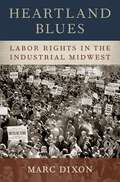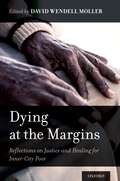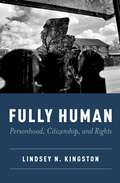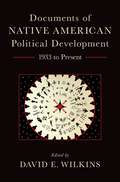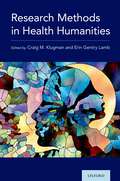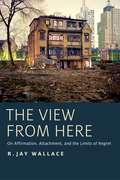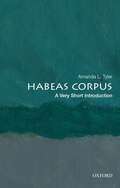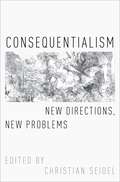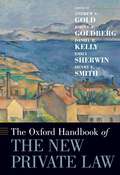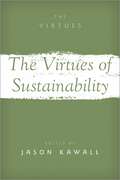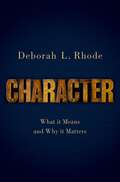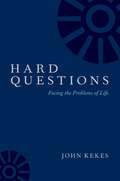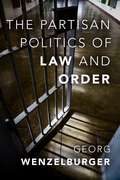- Table View
- List View
Heartland Blues: Labor Rights in the Industrial Midwest
by Marc DixonThe Midwest experienced an upheaval over labor rights beginning in the winter of 2011. For most commentators, the fallout in the Midwest and unions' weak showing in the 2016 presidential election a few years later was just more evidence of labor's emaciated state. In Heartland Blues, Marc Dixon provides a new perspective on union decline by revisiting the labor movement at its historical peak in the late 1950s. Drawing on social movement theories and archival materials, he analyzes campaigns over key labor policies as they were waged in the heavily unionized states of Indiana, Ohio and Wisconsin-the very same states at the center of more recent battles over labor rights. He shows how many of the key ingredients necessary for less powerful groups to succeed, including effective organization and influential political allies, were not a given for labor at the time, but instead varied in important ways across the industrial heartland. Thus, the labor movement's social and political isolation and their limited responses to employer mobilization became a death knell in the ensuing decades, as unions sought organizational and legislative remedies to industrial decline and the rising anti-union tide. Showing how labor rights have been challenged in significant ways in the industrial Midwest in the 1950s, Heartland Blues both identifies enduring problems for labor and forces scholars to look beyond size when seeking clues to labor's failures and successes.
Heartland Blues: Labor Rights in the Industrial Midwest
by Marc DixonThe Midwest experienced an upheaval over labor rights beginning in the winter of 2011. For most commentators, the fallout in the Midwest and unions' weak showing in the 2016 presidential election a few years later was just more evidence of labor's emaciated state. In Heartland Blues, Marc Dixon provides a new perspective on union decline by revisiting the labor movement at its historical peak in the late 1950s. Drawing on social movement theories and archival materials, he analyzes campaigns over key labor policies as they were waged in the heavily unionized states of Indiana, Ohio and Wisconsin-the very same states at the center of more recent battles over labor rights. He shows how many of the key ingredients necessary for less powerful groups to succeed, including effective organization and influential political allies, were not a given for labor at the time, but instead varied in important ways across the industrial heartland. Thus, the labor movement's social and political isolation and their limited responses to employer mobilization became a death knell in the ensuing decades, as unions sought organizational and legislative remedies to industrial decline and the rising anti-union tide. Showing how labor rights have been challenged in significant ways in the industrial Midwest in the 1950s, Heartland Blues both identifies enduring problems for labor and forces scholars to look beyond size when seeking clues to labor's failures and successes.
Love at Last Sight: Dating, Intimacy, and Risk in Turn-of-the-Century Berlin
by Tyler CarringtonIn June 1914, a seamstress named Frieda Kliem left Berlin on a commuter train to meet the man she had fallen in love with through a newspaper personal ad. Instead of proposing marriage, the man lured her into the forest, murdered her, and stole the few valuables she had in her apartment. Through Kliem's story, Love at Last Sight examines the risk associated with modern approaches to dating and finding love in the turn-of-the-century metropolis. Using newspapers, diaries, police records, and court cases, it reveals the strangers, swindlers, and traditional middle-class values that threatened single people looking for intimacy in new ways. For most men and women, using modern technologies to seek romance-making an acquaintance on the street, pursuing a missed connection from a streetcar, or paying for a matchmaking service or personal ad-meant putting one's livelihood, respectability, and life on the line. Those attracted to the opposite and same sex alike experimented with these and other novel approaches, including looking for mates at their workplaces, apartment buildings, dance halls, and bars. In doing so, they navigated traditional and modern class and gender norms in search of financial stability and personal fulfillment. Love at Last Sight exposes the tensions of romance in the modern city as turn-of-the-century Berliners found the metropolis a place of new opportunities to find meaningful connections, as well as a site of isolation, alienation, and danger.
Love at Last Sight: Dating, Intimacy, and Risk in Turn-of-the-Century Berlin
by Tyler CarringtonIn June 1914, a seamstress named Frieda Kliem left Berlin on a commuter train to meet the man she had fallen in love with through a newspaper personal ad. Instead of proposing marriage, the man lured her into the forest, murdered her, and stole the few valuables she had in her apartment. Through Kliem's story, Love at Last Sight examines the risk associated with modern approaches to dating and finding love in the turn-of-the-century metropolis. Using newspapers, diaries, police records, and court cases, it reveals the strangers, swindlers, and traditional middle-class values that threatened single people looking for intimacy in new ways. For most men and women, using modern technologies to seek romance-making an acquaintance on the street, pursuing a missed connection from a streetcar, or paying for a matchmaking service or personal ad-meant putting one's livelihood, respectability, and life on the line. Those attracted to the opposite and same sex alike experimented with these and other novel approaches, including looking for mates at their workplaces, apartment buildings, dance halls, and bars. In doing so, they navigated traditional and modern class and gender norms in search of financial stability and personal fulfillment. Love at Last Sight exposes the tensions of romance in the modern city as turn-of-the-century Berliners found the metropolis a place of new opportunities to find meaningful connections, as well as a site of isolation, alienation, and danger.
Dying at the Margins: Reflections on Justice and Healing for Inner-City Poor
Dying at the Margins: Reflections on Justice and Healing for Inner-City Poor gives voice to the most vulnerable and disempowered population-the urban dying poor- and connects them to the voices of leaders in end-of-life-care. Chapters written by these experts in the field discuss the issues that challenge patients and their loved ones, as well as offering insights into how to improve the quality of their lives. In an illuminating and timely follow up to Dancing with Broken Bones, all discussions revolve around the actual experiences of the patients previously documented, encouraging a greater understanding about the needs of the dying poor, advocating for them, and developing best practices in caring. Demystifying stereotypes that surround poverty, Moller illuminates how faith, remarkable optimism, and an unassailable spirit provide strength and courage to the dying poor.Dying at the Margins serves as a rallying call for not only end-of-life professionals, but compassionate individuals everywhere, to understand and respond to the needs of the especially vulnerable, yet inspiring, people who comprise the world of the inner city dying poor.
Dying at the Margins: Reflections on Justice and Healing for Inner-City Poor
by David Wendell MollerDying at the Margins: Reflections on Justice and Healing for Inner-City Poor gives voice to the most vulnerable and disempowered population-the urban dying poor- and connects them to the voices of leaders in end-of-life-care. Chapters written by these experts in the field discuss the issues that challenge patients and their loved ones, as well as offering insights into how to improve the quality of their lives. In an illuminating and timely follow up to Dancing with Broken Bones, all discussions revolve around the actual experiences of the patients previously documented, encouraging a greater understanding about the needs of the dying poor, advocating for them, and developing best practices in caring. Demystifying stereotypes that surround poverty, Moller illuminates how faith, remarkable optimism, and an unassailable spirit provide strength and courage to the dying poor.Dying at the Margins serves as a rallying call for not only end-of-life professionals, but compassionate individuals everywhere, to understand and respond to the needs of the especially vulnerable, yet inspiring, people who comprise the world of the inner city dying poor.
FULLY HUMAN: Personhood, Citizenship, and Rights
by Lindsey N. KingstonCitizenship within our current international system signifies being fully human, or being worthy of fundamental human rights. For some vulnerable groups, however, this form of political membership is limited or missing entirely, and they face human rights challenges despite a prevalence of international human rights law. These protection gaps are central to hierarchies of personhood, or inequalities that render some people more "worthy" than others for protections and political membership. As a remedy, Lindsey N. Kingston proposes the ideal of "functioning citizenship," which requires an active and mutually-beneficial relationship between the state and the individual and necessitates the opening of political space for those who cannot be neatly categorized. It signifies membership in a political community, in which citizens support their government while enjoying the protections and services associated with their privileged legal status. At the same time, an inclusive understanding of functioning citizenship also acknowledges that political membership cannot always be limited by the borders of the state or proven with a passport. Fully Human builds its theory by looking at several hierarchies of personhood, from the stateless to the forcibly displaced, migrants, nomadic peoples, indigenous nations, and "second class" citizens in the United States. It challenges the binary between citizen and noncitizen, arguing that rights are routinely violated in the space between the two. By recognizing these realities, we uncover limitations built into our current international system--but also begin to envision a path toward the realization of human rights norms founded on universality and inalienability. The ideal of functioning citizenship acknowledges the persistent power of the state, yet it does not rely solely on traditional conceptions of citizenship that have proven too flawed and limited for securing true rights protection.
Fully Human: Personhood, Citizenship, and Rights
by Lindsey N. KingstonCitizenship within our current international system signifies being fully human, or being worthy of fundamental human rights. For some vulnerable groups, however, this form of political membership is limited or missing entirely, and they face human rights challenges despite a prevalence of international human rights law. These protection gaps are central to hierarchies of personhood, or inequalities that render some people more "worthy" than others for protections and political membership. As a remedy, Lindsey N. Kingston proposes the ideal of "functioning citizenship," which requires an active and mutually-beneficial relationship between the state and the individual and necessitates the opening of political space for those who cannot be neatly categorized. It signifies membership in a political community, in which citizens support their government while enjoying the protections and services associated with their privileged legal status. At the same time, an inclusive understanding of functioning citizenship also acknowledges that political membership cannot always be limited by the borders of the state or proven with a passport. Fully Human builds its theory by looking at several hierarchies of personhood, from the stateless to the forcibly displaced, migrants, nomadic peoples, indigenous nations, and "second class" citizens in the United States. It challenges the binary between citizen and noncitizen, arguing that rights are routinely violated in the space between the two. By recognizing these realities, we uncover limitations built into our current international system--but also begin to envision a path toward the realization of human rights norms founded on universality and inalienability. The ideal of functioning citizenship acknowledges the persistent power of the state, yet it does not rely solely on traditional conceptions of citizenship that have proven too flawed and limited for securing true rights protection.
DOCUM OF NATIVE AMER POLIT DEVEL C: 1933 to Present
by David E. WilkinsBefore Europeans arrived in what is now known as the United States, over 600 diverse Native nations lived on the same land. This encroachment and subsequent settlement by Americans forcibly disrupted the lives of all indigenous peoples and brought about staggering depopulation, loss of land, and cultural, religious, and economic changes. These developments also wrought profound changes in indigenous politics and longstanding governing institutions. David E. Wilkins' two-volume work Documents of Native American Political Development traces how indigenous peoples have maintained and continued to exercise a significant measure of self-determination contrary to presumptions that such powers had been lost, surrendered, or vanquished. Volume One provided materials from the 1500s to 1933. This collection of primary source and other documents begins in 1933 and spans the subsequent eight decades. Broadly, the volume organizes this period into the following distinctive eras: indigenous political resurgence and reorganization (1934 to 1940s); indigenous termination/relocation (1940s to 1960s); indigenous self-determination (1960s to 1980s); and indigenous self-governance (1980s to present). Wilkins presents documents including the governing arrangements Native nations created and adapted that are comparable to formal constitutions; international and interest group records; statements by prominent Native and non-Native individuals; and sources featuring important innovations that display the political acumen of Native nations. The documents are arranged chronologically, and Wilkins provides concise, introductory essays to each document, placing them within the proper context. Each introduction is followed by a brief list of suggestions for further reading. This continued examination of fascinating and relatively unknown indigenous history, from a number of influential legal and political writings to the formal constitutions crafted since the American intervention of the Indian Reorganization Act of 1934, will be an invaluable resource for scholars and students of the history, law, and political development of Native peoples.
Research Methods in Health Humanities
Research Methods in Health Humanities surveys the diverse and unique research methods used by scholars in the growing, transdisciplinary field of health humanities. Appropriate for advanced undergraduates, but rich enough to engage more seasoned students and scholars, this volume is an essential teaching and reference tool for health humanities teachers and scholars. Health humanities is a field committed to social justice and to applying expertise to real world concerns, creating research that translates to participants and communities in meaningful and useful ways. The chapters in this field-defining volume reflect these values by examining the human aspects of health and health care that are critical, reflective, textual, contextual, qualitative, and quantitative. Divided into four sections, the volume demonstrates how to conduct research on texts, contexts, people, and programs. Readers will find research methods from traditional disciplines adapted to health humanities work, such as close reading of diverse texts, archival research, ethnography, interviews, and surveys. The book also features transdisciplinary methods unique to the health humanities, such as health and social justice studies, digital health humanities, and community dialogues. Each chapter provides learning objectives, step-by-step instructions, resources, and exercises, with illustrations of the method provided by the authors' own research. An invaluable tool in learning, curricular development, and research design, this volume provides a grounding in the traditions of the humanities, fine arts, and social sciences for students considering health care careers, but also provides useful tools of inquiry for everyone, as we are all future patients and future caregivers of a loved one.
Research Methods in Health Humanities
by Craig M. Klugman and Erin Gentry LambResearch Methods in Health Humanities surveys the diverse and unique research methods used by scholars in the growing, transdisciplinary field of health humanities. Appropriate for advanced undergraduates, but rich enough to engage more seasoned students and scholars, this volume is an essential teaching and reference tool for health humanities teachers and scholars. Health humanities is a field committed to social justice and to applying expertise to real world concerns, creating research that translates to participants and communities in meaningful and useful ways. The chapters in this field-defining volume reflect these values by examining the human aspects of health and health care that are critical, reflective, textual, contextual, qualitative, and quantitative. Divided into four sections, the volume demonstrates how to conduct research on texts, contexts, people, and programs. Readers will find research methods from traditional disciplines adapted to health humanities work, such as close reading of diverse texts, archival research, ethnography, interviews, and surveys. The book also features transdisciplinary methods unique to the health humanities, such as health and social justice studies, digital health humanities, and community dialogues. Each chapter provides learning objectives, step-by-step instructions, resources, and exercises, with illustrations of the method provided by the authors' own research. An invaluable tool in learning, curricular development, and research design, this volume provides a grounding in the traditions of the humanities, fine arts, and social sciences for students considering health care careers, but also provides useful tools of inquiry for everyone, as we are all future patients and future caregivers of a loved one.
The View from Here: On Affirmation, Attachment, and the Limits of Regret
by R. Jay WallaceMust we always later regret actions that were wrong for us to perform at the time? Can there ever be good reason to affirm things in the past that we know were unfortunate? In this original work of moral philosophy, R. Jay Wallace shows that the standpoint from which we look back on our lives is shaped by our present attachments-to persons, to the projects that imbue our lives with meaning, and to life itself. Through a distinctive "affirmation dynamic", these attachments commit us to affirming the necessary conditions of their objects. The result is that we are sometimes unable to regret events and circumstances that were originally unjustified or otherwise somehow objectionable. Wallace traces these themes through a range of examples. A teenage girl makes an ill-advised decision to conceive a child - but her love for the child once it has been born makes it impossible for her to regret that earlier decision. The painter Paul Gauguin abandons his family to pursue his true artistic calling (and eventual life project) in Tahiti--which means he cannot truly regret his abdication of familial responsibility. The View from Here offers new interpretations of these classic cases, challenging their treatment by Bernard Williams and others. Another example is the "bourgeois predicament": we are committed to affirming the regrettable social inequalities that make possible the expensive activities that give our lives meaning. Generalizing from such situations, Wallace defends the view that our attachments inevitably commit us to affirming historical conditions that we cannot regard as worthy of being affirmed--a modest form of nihilism.
Habeas Corpus: A Very Short Introduction (Very Short Introduction)
by Amanda L. TylerLegal scholar Amanda L. Tyler discusses the history and future of habeas corpus in America and around the world. The concept of habeas corpus--literally, to receive and hold the body--empowers courts to protect the right of prisoners to know the basis on which they are being held by the government and grant prisoners their freedom when they are held unlawfully. It is no wonder that habeas corpus has long been considered essential to freedom. For nearly eight hundred years, the writ of habeas corpus has limited the executive in the Anglo-American legal tradition from imprisoning citizens and subjects with impunity. Writing in the eighteenth century, the widely influential English jurist and commentator William Blackstone declared the writ a "bulwark" of personal liberty. Across the Atlantic, in the leadup to the American Revolution, the Continental Congress declared that the habeas privilege and the right to trial by jury were among the most important rights in a free society. This Very Short Introduction chronicles the storied writ of habeas corpus and how its common law and statutory origins spread from England throughout the British Empire and beyond, witnessing its use today around the world in nations as varied as Canada, Israel, India, and South Korea. Beginning with the English origins of the writ, the book traces its historical development both as a part of the common law and as a parliamentary creation born out of the English Habeas Corpus Act of 1679, a statute that so dramatically limited the executive's power to detain that Blackstone called it no less than a "second Magna Carta." The book then takes the story forward to explore how the writ has functioned in the centuries since, including its controversial suspension by President Abraham Lincoln during the Civil War. It also analyzes the major role habeas corpus has played in such issues as the World War II incarceration of Japanese Americans and the US Supreme Court's recognition during the War on Terror of the concept of a "citizen enemy combatant." Looking ahead the story told in these pages reveals the immense challenges that the habeas privilege faces today and suggests that in confronting them, we would do well to remember how the habeas privilege brought even the king of England to his knees before the law.
Habeas Corpus: From The Tower Of London To Guantanamo Bay (Very Short Introduction)
by Amanda L. TylerLegal scholar Amanda L. Tyler discusses the history and future of habeas corpus in America and around the world. The concept of habeas corpus--literally, to receive and hold the body--empowers courts to protect the right of prisoners to know the basis on which they are being held by the government and grant prisoners their freedom when they are held unlawfully. It is no wonder that habeas corpus has long been considered essential to freedom. For nearly eight hundred years, the writ of habeas corpus has limited the executive in the Anglo-American legal tradition from imprisoning citizens and subjects with impunity. Writing in the eighteenth century, the widely influential English jurist and commentator William Blackstone declared the writ a "bulwark" of personal liberty. Across the Atlantic, in the leadup to the American Revolution, the Continental Congress declared that the habeas privilege and the right to trial by jury were among the most important rights in a free society. This Very Short Introduction chronicles the storied writ of habeas corpus and how its common law and statutory origins spread from England throughout the British Empire and beyond, witnessing its use today around the world in nations as varied as Canada, Israel, India, and South Korea. Beginning with the English origins of the writ, the book traces its historical development both as a part of the common law and as a parliamentary creation born out of the English Habeas Corpus Act of 1679, a statute that so dramatically limited the executive's power to detain that Blackstone called it no less than a "second Magna Carta." The book then takes the story forward to explore how the writ has functioned in the centuries since, including its controversial suspension by President Abraham Lincoln during the Civil War. It also analyzes the major role habeas corpus has played in such issues as the World War II incarceration of Japanese Americans and the US Supreme Court's recognition during the War on Terror of the concept of a "citizen enemy combatant." Looking ahead the story told in these pages reveals the immense challenges that the habeas privilege faces today and suggests that in confronting them, we would do well to remember how the habeas privilege brought even the king of England to his knees before the law.
Consequentialism: New Directions, New Problems (Oxford Moral Theory)
by Christian SeidelConsequentialism is a focal point of discussion and a driving force behind important developments in moral philosophy. Recently, the debate has shifted in focus and in style. By seeking to consequentialize rival moral theories, in particular those with agent-relative characteristics, and by framing accounts in terms of reasons rather than in terms of value, an emerging new wave consequentialism has presented - at much higher levels of abstraction - theories which proved extremely flexible and powerful in meeting long-standing and influential objections. This volume of new essays on new wave consequentialism initiates and stimulates novel lines of discussions among proponents and their critics. The contributions explore new directions in new wave consequentialism and present refined conceptual frameworks (in Part I), raise challenging fundamental problems for these frameworks and the new wave's theoretical basis (in Part II), and give a balanced assessment of the new wave's limits and achievements in specific contexts of commonsense moral practice (in Part III). The volume will be of interest to all readers in ethical and moral theory.
The Oxford Handbook of the New Private Law (Oxford Handbooks)
The Oxford Handbook of the New Private Law reflects exciting developments in scholarship dedicated to reinvigorating the study of the broad field of private law. This field embraces the traditional common law subjects (property, contracts, and torts), as well as adjacent, more statutory areas, such as intellectual property and commercial law. It also includes important areas that have been neglected in the United States but are beginning to make a comeback. These include unjust enrichment, restitution, equity, and remedies more generally. "Private law" can also mean private law as a whole, which invites consideration of issues such as the public-private distinction, the similarities and differences between the various areas of private law, and the institutional framework supporting private law - including courts, arbitrators, and even custom. The New Private Law is an approach to these subjects that aims to bring a new outlook to the study of private law by moving beyond reductively instrumentalist policy evaluation and narrow, rule-by-rule, doctrine-by-doctrine analysis, so as to consider and capture how private law's various features fit and work together, as well as the normative underpinnings of these larger structures. This movement has begun resuscitating the notion of private law itself in the United States and has brought an interdisciplinary perspective to the more traditional, doctrinal approach prevalent in Commonwealth countries. The Handbook embraces a broad range of perspectives to private law - including philosophical, economic, historical, and psychological, to name a few - yet it offers a unifying theme of seriousness about the structure and content of private law. It will be an essential resource for legal scholars interested in the future of this important field.
The Oxford Handbook of the New Private Law (Oxford Handbooks)
by Emily Sherwin Andrew S. Gold Henry E. Smith John C.P. Goldberg Daniel B. KellyThe Oxford Handbook of the New Private Law reflects exciting developments in scholarship dedicated to reinvigorating the study of the broad field of private law. This field embraces the traditional common law subjects (property, contracts, and torts), as well as adjacent, more statutory areas, such as intellectual property and commercial law. It also includes important areas that have been neglected in the United States but are beginning to make a comeback. These include unjust enrichment, restitution, equity, and remedies more generally. "Private law" can also mean private law as a whole, which invites consideration of issues such as the public-private distinction, the similarities and differences between the various areas of private law, and the institutional framework supporting private law - including courts, arbitrators, and even custom. The New Private Law is an approach to these subjects that aims to bring a new outlook to the study of private law by moving beyond reductively instrumentalist policy evaluation and narrow, rule-by-rule, doctrine-by-doctrine analysis, so as to consider and capture how private law's various features fit and work together, as well as the normative underpinnings of these larger structures. This movement has begun resuscitating the notion of private law itself in the United States and has brought an interdisciplinary perspective to the more traditional, doctrinal approach prevalent in Commonwealth countries. The Handbook embraces a broad range of perspectives to private law - including philosophical, economic, historical, and psychological, to name a few - yet it offers a unifying theme of seriousness about the structure and content of private law. It will be an essential resource for legal scholars interested in the future of this important field.
The Virtues of Sustainability (The Virtues)
From climate change to species extinction, and habitat loss to soil degradation, a stark awareness of the often devastating impacts of human actions is growing. People around the world are urgently seeking sustainable ways of life for themselves and their communities. But what do these calls for a sustainable future mean for our current values and ways of life, and what kind of people will we need to become? Though sustainability is a ubiquitous concept with a range of meaning and applications, this volume shows that it can be significantly understood and sought through the notion of virtue, in the tradition of virtue ethics. Approaches to ethical living that emphasize good character and virtue are resurgent, and especially well-suited to addressing our present challenges. From rethinking excessive consumption, to appropriately respecting nature, to finding resilience in the face of environmental injustice, our characters will be frequently tested. The virtues of sustainability--character traits enabling us to lead sustainable, flourishing lives--will be critical to our success. This volume, divided into three sections, brings together newly-commissioned essays by leading scholars from multiple disciplines--from philosophy and political science, to religious studies and psychology. The essays in the first section focus on key factors and structures that support the cultivation of the virtues of sustainability, while those in the second focus in particular on virtues embraced by non-Western communities and cultures, and the worldviews that underlie them. Finally, the essays in the third section each address further particular virtues of sustainability, including cooperativeness, patience, conscientiousness, creativity, and open-mindedness. Together, these essays provide readers with a rich understanding of the importance and diversity of the virtues of sustainability, and practical guidance towards their cultivation.
VIRTUES OF SUSTAINABILITY BVS C (The Virtues)
by Jason KawallFrom climate change to species extinction, and habitat loss to soil degradation, a stark awareness of the often devastating impacts of human actions is growing. People around the world are urgently seeking sustainable ways of life for themselves and their communities. But what do these calls for a sustainable future mean for our current values and ways of life, and what kind of people will we need to become? Though sustainability is a ubiquitous concept with a range of meaning and applications, this volume shows that it can be significantly understood and sought through the notion of virtue, in the tradition of virtue ethics. Approaches to ethical living that emphasize good character and virtue are resurgent, and especially well-suited to addressing our present challenges. From rethinking excessive consumption, to appropriately respecting nature, to finding resilience in the face of environmental injustice, our characters will be frequently tested. The virtues of sustainability--character traits enabling us to lead sustainable, flourishing lives--will be critical to our success. This volume, divided into three sections, brings together newly-commissioned essays by leading scholars from multiple disciplines--from philosophy and political science, to religious studies and psychology. The essays in the first section focus on key factors and structures that support the cultivation of the virtues of sustainability, while those in the second focus in particular on virtues embraced by non-Western communities and cultures, and the worldviews that underlie them. Finally, the essays in the third section each address further particular virtues of sustainability, including cooperativeness, patience, conscientiousness, creativity, and open-mindedness. Together, these essays provide readers with a rich understanding of the importance and diversity of the virtues of sustainability, and practical guidance towards their cultivation.
Character: What it Means and Why it Matters
by Deborah L. RhodeAmericans claim to care about character. Over four fifths want it taught in public schools, and 95 percent think that a president's character is important. And historically, philosophers, educators, politicians, religious leaders, judges, and the general public have agreed that character should be valued and reinforced. Yet in the United States, the institutions charged with that mission have consistently fallen short. Simply put, too little effort has been made to understand the importance of character and the strategies that can best develop and support it. After first exploring the history of the concept over time, Deborah Rhode turns her focus to the institutions that have traditionally fostered good character: families, schools, youth organizations, civic groups, and political organizations. However, as we have increasingly de-emphasized the subject-a trend that is most evident in our politics-our awareness of its shaping influence has waned. Indeed, we often focus on the wrong things when it comes to fostering good character. For instance, almost a third of the workforce is covered by licensing laws requiring good moral character, even occupations where the need for screening is not self-evident: florist, fortune teller, and frog farmers. Character also plays a pivotal role in the criminal justice system, in defining guilt, punishment, and eligibility for parole. All too often, these legal requirements are idiosyncratic, inequitable, and subject to race and class bias. Millions of Americans who have convictions for minor offenses are excluded from a vast range of occupations and benefits without evidence that such exclusion serves the public interest. We can do better, she stresses, and outlines a powerful program for reform. Rhode punctuates the book through a series of portraits of exemplary individuals whose good character made them who they were: Ida B. Wells, Jane Addams, Martin Luther King, Mother Teresa, Nelson Mandela, Albert Schweitzer, and Thurgood Marshall. All of these individuals had flaws, but through their commitments to both social justice and helping the less fortunate, they all demonstrate the power and importance of strong character.
Character: What it Means and Why it Matters
by Deborah L. RhodeAmericans claim to care about character. Over four fifths want it taught in public schools, and 95 percent think that a president's character is important. And historically, philosophers, educators, politicians, religious leaders, judges, and the general public have agreed that character should be valued and reinforced. Yet in the United States, the institutions charged with that mission have consistently fallen short. Simply put, too little effort has been made to understand the importance of character and the strategies that can best develop and support it. After first exploring the history of the concept over time, Deborah Rhode turns her focus to the institutions that have traditionally fostered good character: families, schools, youth organizations, civic groups, and political organizations. However, as we have increasingly de-emphasized the subject-a trend that is most evident in our politics-our awareness of its shaping influence has waned. Indeed, we often focus on the wrong things when it comes to fostering good character. For instance, almost a third of the workforce is covered by licensing laws requiring good moral character, even occupations where the need for screening is not self-evident: florist, fortune teller, and frog farmers. Character also plays a pivotal role in the criminal justice system, in defining guilt, punishment, and eligibility for parole. All too often, these legal requirements are idiosyncratic, inequitable, and subject to race and class bias. Millions of Americans who have convictions for minor offenses are excluded from a vast range of occupations and benefits without evidence that such exclusion serves the public interest. We can do better, she stresses, and outlines a powerful program for reform. Rhode punctuates the book through a series of portraits of exemplary individuals whose good character made them who they were: Ida B. Wells, Jane Addams, Martin Luther King, Mother Teresa, Nelson Mandela, Albert Schweitzer, and Thurgood Marshall. All of these individuals had flaws, but through their commitments to both social justice and helping the less fortunate, they all demonstrate the power and importance of strong character.
Hard Questions: Facing the Problems of Life
by John KekesIn this book, John Kekes discusses the hard questions we all must face in the course of our lives. Is there an absolute value that overrides all other considerations? Must we conform to prevailing conventions? Do we owe what our country asks of us? Must justice be done at all costs? How should we respond to evil? Should we forgive wrong actions? Does shame make life better or worse? Is it always good to be true to who we are? Do good intentions justify bad actions? Are moral values the highest of all values? There are reasonable answers to these questions, but we find that they often conflict. Their conflicts compel us to weigh the consequences of how the decisions we make affect ourselves, our relationships, and our attitude to the society in which we live. In this clearly and accessibly written book, Kekes compares and evaluates the reasons that have been given for and against answers to these hard questions by those who actually faced them. By learning from the successes and failures of the decisions others have made, we can understand better how we should respond to the hard questions we ourselves face. We can then evaluate more reasonably the possibilities open to us and the limitations to which we are subject. This approach is an alternative to both the absolutist and the relativist ways of trying to answer hard questions. Absolutists have, for millennia, fruitlessly searched for an authoritative answer that reason requires everyone to accept. Their failure have led relativists to assume that there comes a point at which we run out of reasons and have no option but to make an arbitrary decision. Kekes instead offers a message of hope by showing that there are reasonable answers to hard questions, which are neither absolute, nor arbitrary.
Hard Questions: Facing the Problems of Life
by John KekesIn this book, John Kekes discusses the hard questions we all must face in the course of our lives. Is there an absolute value that overrides all other considerations? Must we conform to prevailing conventions? Do we owe what our country asks of us? Must justice be done at all costs? How should we respond to evil? Should we forgive wrong actions? Does shame make life better or worse? Is it always good to be true to who we are? Do good intentions justify bad actions? Are moral values the highest of all values? There are reasonable answers to these questions, but we find that they often conflict. Their conflicts compel us to weigh the consequences of how the decisions we make affect ourselves, our relationships, and our attitude to the society in which we live. In this clearly and accessibly written book, Kekes compares and evaluates the reasons that have been given for and against answers to these hard questions by those who actually faced them. By learning from the successes and failures of the decisions others have made, we can understand better how we should respond to the hard questions we ourselves face. We can then evaluate more reasonably the possibilities open to us and the limitations to which we are subject. This approach is an alternative to both the absolutist and the relativist ways of trying to answer hard questions. Absolutists have, for millennia, fruitlessly searched for an authoritative answer that reason requires everyone to accept. Their failure have led relativists to assume that there comes a point at which we run out of reasons and have no option but to make an arbitrary decision. Kekes instead offers a message of hope by showing that there are reasonable answers to hard questions, which are neither absolute, nor arbitrary.
The Partisan Politics of Law and Order (Studies in Crime and Public Policy)
by Georg WenzelburgerWhereas some Western democracies have turned toward substantially tougher law and order policies, others have not. How can we account for this discrepancy? In The Partisan Politics of Law and Order, Georg Wenzelburger argues that partisan politics have shaped the development of law and order policies in Western countries over the past twenty-five years. Wenzelburger establishes an integrated framework based on issue competition, institutional context, and policy feedback as the driving factors shaping penal policy. Using a large-scale quantitative analysis of twenty Western industrialized countries covering the period from 1995 to 2012, supplemented by case studies in the United Kingdom, Germany, France, and Sweden, Wenzelburger presents robust empirical evidence for the central role of political parties in law-and-order policy-making. By demonstrating how the configuration of party systems and institutional context affect law and order policies, this book addresses an understudied but key dynamic in penal legislation. The argument and evidence presented here will be of interest to political scientists, sociologists, criminologists, and criminal justice scholars.
The Partisan Politics of Law and Order (Studies in Crime and Public Policy)
by Georg WenzelburgerWhereas some Western democracies have turned toward substantially tougher law and order policies, others have not. How can we account for this discrepancy? In The Partisan Politics of Law and Order, Georg Wenzelburger argues that partisan politics have shaped the development of law and order policies in Western countries over the past twenty-five years. Wenzelburger establishes an integrated framework based on issue competition, institutional context, and policy feedback as the driving factors shaping penal policy. Using a large-scale quantitative analysis of twenty Western industrialized countries covering the period from 1995 to 2012, supplemented by case studies in the United Kingdom, Germany, France, and Sweden, Wenzelburger presents robust empirical evidence for the central role of political parties in law-and-order policy-making. By demonstrating how the configuration of party systems and institutional context affect law and order policies, this book addresses an understudied but key dynamic in penal legislation. The argument and evidence presented here will be of interest to political scientists, sociologists, criminologists, and criminal justice scholars.
